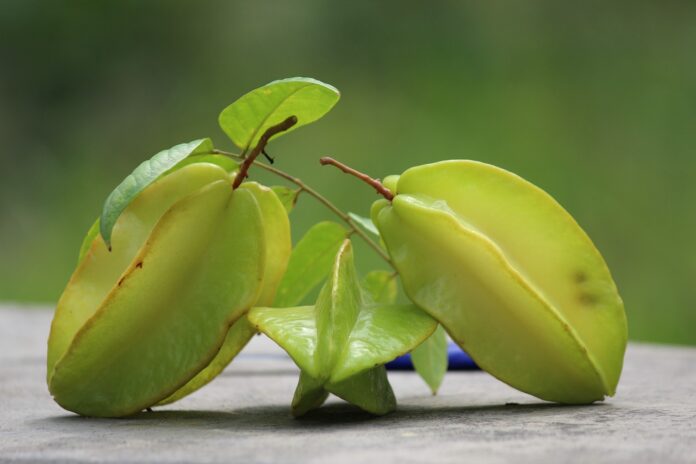Carambola, commonly known as starfruit, is a tropical fruit known for its distinctive star shape when sliced crosswise. Native to Southeast Asia, the fruit has gained popularity worldwide due to its unique appearance and sweet-tart flavor. The outer skin of the carambola is thin, smooth, and waxy, usually a shade of yellow or light green when ripe. Its flesh is juicy and crisp, and depending on the variety, it can range in taste from mildly sweet to tangy.
Interesting Facts About Carambola (Star Fruit):
- Origin: Carambola hails from Southeast Asia, particularly from regions like Malaysia, Indonesia, and the Philippines. Today, it is widely cultivated in tropical and subtropical areas such as South America, the Caribbean, and southern regions of the United States, including Florida and Hawaii. The plant thrives in these regions due to its need for warm, frost-free environments
- Scientific Classification: Known scientifically as Averrhoa carambola, carambola belongs to the Oxalidaceae family, commonly known as the wood sorrel family. This botanical connection highlights its similarity to other acidic-tasting plants like sorrel
- Flavor: The flavor of carambola is often described as a delightful blend of pineapple, lemon, and apple. This unique taste, combined with its crisp texture, makes it appealing for both sweet and savory culinary applications
- Distinctive Shape: One of the most recognizable features of carambola is its star shape when sliced crosswise. This unique appearance not only gives the fruit its common name, “starfruit,” but also makes it a popular choice for decorative uses in salads and garnishes
- Nutritional Profile: Starfruit is highly nutritious, offering about 31 calories per 100 grams. It is an excellent source of vitamin C, which supports the immune system, and provides dietary fiber that aids in digestion. Additionally, it contains beneficial antioxidants that help combat oxidative stress and lower the risk of chronic diseases
- Water Content: Carambola has a high water content, making up about 91% of the fruit. This attribute makes it an excellent choice for hydration, particularly in tropical climates where it grows naturally
- Varieties: There are two primary types of carambola: sweet and sour. The sweet variety is usually enjoyed fresh, while the sour type is more commonly used in cooking, especially in savory dishes like curries or as a tangy addition to chutneys and salads. Both varieties have a crisp, juicy texture
- Health Accidents: Carambola (starfruit) contains a neurotoxin that is particularly dangerous for individuals with kidney conditions. Consuming carambola can lead to confusion, seizures, and, in severe cases, death, especially in those unable to filter the toxin adequately due to kidney dysfunction
- Enzyme Interaction: Starfruit contains compounds that inhibit the enzyme CYP3A4, which is crucial for metabolizing many medications. This interaction can significantly alter drug effectiveness and lead to serious side effects, so people on certain medications should avoid the fruit
- Growth and Yield: Carambola trees can reach heights of 25 to 30 feet and begin to bear fruit about three to four years after planting. A mature tree can produce between 200 to 400 pounds of fruit annually, provided it is grown in well-drained, fertile soil and has sufficient sunlight
- Plant Behavior: The carambola tree exhibits a fascinating phenomenon known as seismonastic movement, where its leaves fold in response to stimuli like touch, vibration, or at night. This behavior is thought to be a defense mechanism against herbivores and environmental stresses
- Tree Lifespan: Carambola trees are known for their longevity and can live for around 40 years in the wild. With proper care and favorable conditions, they continue to produce fruit throughout their lifespan
